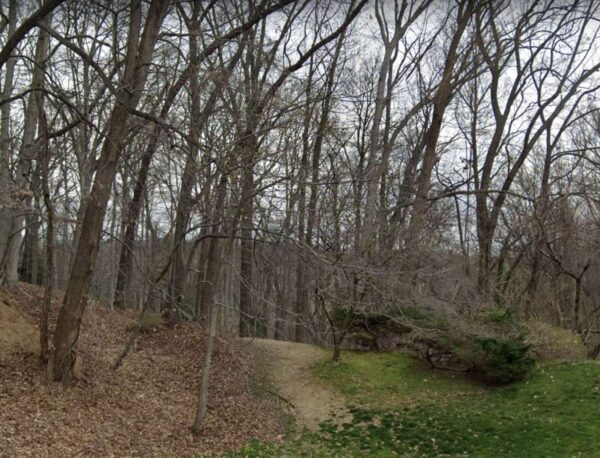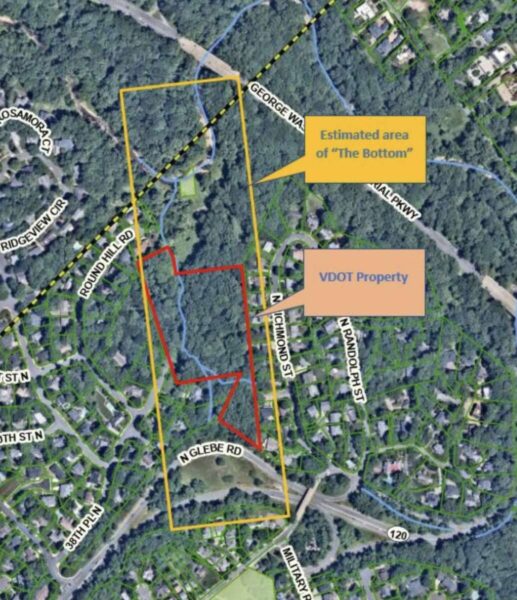
(Updated at 9:15 a.m. on 7/12/23) A secluded wooded area south of Pimmit Run in North Arlington with a little-known history is up for sale and Arlington County could become the buyer.
The county is considering whether to buy a 6.7-acre parcel near the Chain Bridge Forest neighborhood from the Virginia Dept. of Transportation for $2.88 million. The property, between a curving section of N. Glebe Road and Pimmit Run, includes both developable and protected land.
VDOT originally intended to use it for a connector road from N. Glebe Road to Route 123 (Chain Bridge Road) in Fairfax County, which it never built, the county says. It now is giving Arlington first dibs before turning to private buyers. Should the sale go through, the county would set the land aside for public open space.
The property in question sits within the historic boundaries of a near-forgotten settlement by freed Black people who worked the land from the 1850s to the 1950s, according to the county and Jessica Kaplan, a local expert on and author of a definitive 2018 article about the community.
Kaplan pieced her article together from census data, deeds, wills, maps and claims residents made against the government for property it confiscated during the Civil War.
The settlement grew after John Jackson, a free Black man, bought three acres from white landowner William Walker, who he had known since childhood, shortly before the Civil War broke out, Kaplan writes. She says it is unclear if he sold to Jackson because of their friendship or because white people were not interested because it was a low-lying, flood-prone area.
Despite those issues, Jackson went through with the purchase. Walker’s initial sale sparked a small exodus of Black families — who had either escaped slavery, bought their freedom or were born free — from Fairfax County to what is now Arlington.
In what may be a riff on the problems with the land, residents called it “The Bottom,” Kaplan writes. At its peak, 20 families lived there.
“Whether [leasees] or owners, they found relative safety in numbers and in the secluded, timber-lined hollow of The Bottom,” she said. “The Bottom remained their home through challenging times: war, Reconstruction, Jim Crow, segregation, and suburbanization.”

Residents eked out a living farming, tending livestock and quarrying stone, she said. During the Civil War, men helped build nearby Fort Marcy and Fort Ethan Allen while women sold baked goods and did laundry for soldiers. Some of the Union soldiers, however, raided their farms and burned the land for fuel.
With paltry government repayments for confiscated property, the families built back after the war, Kaplan wrote. They farmed, quarried stone and worked for nearby white families. Their children walked three miles to attend the closest school for Black children, then called Sumner School.
The enclave dwindled to non-existence in the 1950s as residents died, moved to other Black neighborhoods in Arlington such as Halls Hill, or left the area. Economic pressures were compounded by access: Arlington County abandoned a road running along The Bottom’s west side and circumvented it with the new N. Glebe Road to Chain Bridge.
Investors ended up owning all the land comprising The Bottom, eventually selling to the U.S. government. Kaplan says the community “became the anchor for an overpass of the George Washington Memorial Parkway.” (more…)

